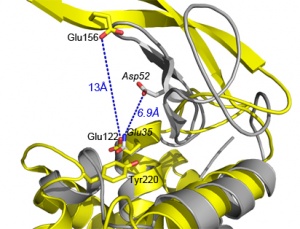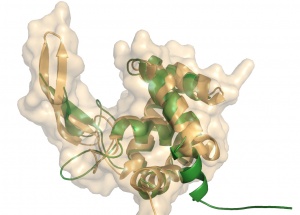CAZypedia needs your help! We have many unassigned GH, PL, CE, AA, GT, and CBM pages in need of Authors and Responsible Curators.
Scientists at all career stages, including students, are welcome to contribute to CAZypedia. Read more here, and in the 10th anniversary article in Glycobiology.
New to the CAZy classification? Read this first.
*
Consider attending the 15th Carbohydrate Bioengineering Meeting in Ghent, 5-8 May 2024.
Difference between revisions of "Glycoside Hydrolase Family 73"
Harry Brumer (talk | contribs) m |
|||
| Line 37: | Line 37: | ||
== Catalytic Residues == | == Catalytic Residues == | ||
| − | The catalytic proton donor is a Glutamate, strickly conserved in the GH73 family. Glu185 in FlgJ and Glu122 in Auto have been unambiguously identified through structural comparisons with the actives sites from GH23, GH22 and GH19 enzymes <cite>Hashimoto2009 Bublitz2009 </cite>. Site-directed mutagenesis confirmed the catalytic role of this Glu in FlgJ <cite>Maruyama2010</cite>, Auto <cite>Bublitz2009</cite> and AcmA <cite>Inagaki2009</cite>. Nevertheless, both structures of FlgJ and Auto have in common the evident lack of a nearby second catalytic carboxylate, provided for instance by Asp52(53) in GH22 lysozymes (see figure 2)[[Image:GH73activesite.jpg|thumb|left|'''Figure 1.''' Comparison of Auto (in yellow) and HEWL (in grey) active sites. Catalytic residues are in italic for HEWL ([[GH22]])]]. In FlgJ and Auto the nucleophile/base, a Glu corresponding to Aps52 is strickly conserved in the GH73 family but takes place 13Å far from the Glu proton donor in the active site. | + | The catalytic proton donor is a Glutamate, strickly conserved in the GH73 family. Glu185 in FlgJ and Glu122 in Auto have been unambiguously identified through structural comparisons with the actives sites from GH23, GH22 and GH19 enzymes <cite>Hashimoto2009 Bublitz2009 </cite>. Site-directed mutagenesis confirmed the catalytic role of this Glu in FlgJ <cite>Maruyama2010</cite>, Auto <cite>Bublitz2009</cite> and AcmA <cite>Inagaki2009</cite>. Nevertheless, both structures of FlgJ and Auto have in common the evident lack of a nearby second catalytic carboxylate, provided for instance by Asp52(53) in GH22 lysozymes (see figure 2)[[Image:GH73activesite.jpg|thumb|left|'''Figure 1.''' Comparison of Auto (in yellow) and HEWL (in grey) active sites. Catalytic residues are in italic for HEWL ([[GH22]])]]. In FlgJ and Auto the nucleophile/base, a Glu corresponding to Aps52, is strickly conserved in the GH73 family but takes place 13Å far from the Glu proton donor in the active site. |
| − | Bublitz et al proposed a single displacement mechanism involving a distant carboxylate (Glu) that would serve as a base assisting a water molecule for the nucleophilic attack on the opposite side of the sugar ring <cite>Bublitz2009</cite> . This mechanism also involves an important displacement | + | Bublitz et al proposed a single displacement mechanism involving a distant carboxylate (Glu) that would serve as a base assisting a water molecule for the nucleophilic attack on the opposite side of the sugar ring <cite>Bublitz2009</cite> . This mechanism also involves an important displacement of the β-lobe harbouring the catalytic Glu upon substrat binding, that would bring this nucleophile base closer to the active site. |
On the other hand, mutational analyses on FlgJ and AcmA revealed another key catalytic residue... | On the other hand, mutational analyses on FlgJ and AcmA revealed another key catalytic residue... | ||
Revision as of 02:08, 23 August 2010
This page is currently under construction. This means that the Responsible Curator has deemed that the page's content is not quite up to CAZypedia's standards for full public consumption. All information should be considered to be under revision and may be subject to major changes.
- Author: ^^^Florence Vincent^^^
- Responsible Curator: ^^^Bernard Henrissat^^^
| Glycoside Hydrolase Family GH73 | |
| Clan | none, α+β "lysozyme fold" |
| Mechanism | not known |
| Active site residues | partially known |
| CAZy DB link | |
| http://www.cazy.org/GH73.html | |
Substrate specificities
The GH73 family is comprised of bacterial or prokaryotic viral members. Most of the enzymes of this family are peptidoglycan hydrolases that cleave the β-1,4-glycosidic linkage between N-acetylglucosaminyl (NAG) and N-acetylmuramyl (NAM) moieties in the carbohydrate backbone of bacterial peptidoglycan. Because of their cleavage specificity, they are commonly described as N-acetylglucosaminidases. The activity of the GH73 is mainly focused in daughter cell separation during vegetative growth and it is very often involved in the hydrolysis of the septum after cell division (Acp from Clostridium Perfringens [1] AltA from Enterococcus faecalis [2]). Only Listeria monocytogene uses Auto as a virulence-associated peptidoglycan hydrolase for host-cell invasion [3]. The GH73 are mostly surface located and exhibit repeated sequences that could be involved in cell-wall binding and therefore reinforce the enzymes catalytic activity. Unknown repeated domains are appended for instance to LytD and LytG from Bacillus subtilis [4, 5], AcmB from Lactococcus lactis [6] and Auto from L. monocytogene [3]. Some of these repeated domains have been identified like CBM50 also known as LysM domain appended to AcmA for Lactococcus lactis [7], AltA from Enterococcus faecalis [2] and Mur2-Mur2 from Enterococcus hirae [8].
Kinetics and Mechanism
No kinetic parameters have been determined for any enzyme of the GH73 family, as the production of synthetic peptidoglycan substrates remains a challenging task.
Catalytic Residues
The catalytic proton donor is a Glutamate, strickly conserved in the GH73 family. Glu185 in FlgJ and Glu122 in Auto have been unambiguously identified through structural comparisons with the actives sites from GH23, GH22 and GH19 enzymes [3, 9]. Site-directed mutagenesis confirmed the catalytic role of this Glu in FlgJ [10], Auto [3] and AcmA [7]. Nevertheless, both structures of FlgJ and Auto have in common the evident lack of a nearby second catalytic carboxylate, provided for instance by Asp52(53) in GH22 lysozymes (see figure 2)

. In FlgJ and Auto the nucleophile/base, a Glu corresponding to Aps52, is strickly conserved in the GH73 family but takes place 13Å far from the Glu proton donor in the active site.
Bublitz et al proposed a single displacement mechanism involving a distant carboxylate (Glu) that would serve as a base assisting a water molecule for the nucleophilic attack on the opposite side of the sugar ring [3] . This mechanism also involves an important displacement of the β-lobe harbouring the catalytic Glu upon substrat binding, that would bring this nucleophile base closer to the active site.
On the other hand, mutational analyses on FlgJ and AcmA revealed another key catalytic residue...
Three-dimensional structures
Crystal structure of GH73 are available and have been coincidently reported, FlgJ from Sphingomonas sp. (SPH1045-C) [9] and Auto a virulence associated peptigoglycan hydrolase from Listeria monocytogenes [3]. A structure for a catalytic mutant (E185A) of FlgJ has been solved by Maruyama et al [10] but doesn’t show any conformational changes. The two GH73 show the same fold, with two subdomains consisting of a β-lobe and an α-lobe that together create an extended substrate binding groove (Figure 1). With a typical lysozyme (α+β) fold, the catalytic domain of Auto is structurally related to the catalytic domain of Slt70 from E. coli [11], the family GH19 chitinases and goose egg-white lysozyme (GEWL, GH23)[12]. FlgJ is structurally related to a peptidoglycan degrading enzyme from the bacteriophage phi 29 [13] and also to family GH22 and GH23 lysozymes.
Family Firsts
- First stereochemistry determination
- Cite some reference here, with a short (1-2 sentence) explanation
- First catalytic nucleophile identification
- Cite some reference here, with a short (1-2 sentence) explanation
- First general acid/base residue identification
- Cite some reference here, with a short (1-2 sentence) explanation
- First 3-D structure
- Cite some reference here, with a short (1-2 sentence) explanation
References
- Camiade E, Peltier J, Bourgeois I, Couture-Tosi E, Courtin P, Antunes A, Chapot-Chartier MP, Dupuy B, and Pons JL. (2010). Characterization of Acp, a peptidoglycan hydrolase of Clostridium perfringens with N-acetylglucosaminidase activity that is implicated in cell separation and stress-induced autolysis. J Bacteriol. 2010;192(9):2373-84. DOI:10.1128/JB.01546-09 |
- Eckert C, Lecerf M, Dubost L, Arthur M, and Mesnage S. (2006). Functional analysis of AtlA, the major N-acetylglucosaminidase of Enterococcus faecalis. J Bacteriol. 2006;188(24):8513-9. DOI:10.1128/JB.01145-06 |
- Bublitz M, Polle L, Holland C, Heinz DW, Nimtz M, and Schubert WD. (2009). Structural basis for autoinhibition and activation of Auto, a virulence-associated peptidoglycan hydrolase of Listeria monocytogenes. Mol Microbiol. 2009;71(6):1509-22. DOI:10.1111/j.1365-2958.2009.06619.x |
- Rashid MH, Mori M, and Sekiguchi J. (1995). Glucosaminidase of Bacillus subtilis: cloning, regulation, primary structure and biochemical characterization. Microbiology (Reading). 1995;141 ( Pt 10):2391-404. DOI:10.1099/13500872-141-10-2391 |
- Horsburgh GJ, Atrih A, Williamson MP, and Foster SJ. (2003). LytG of Bacillus subtilis is a novel peptidoglycan hydrolase: the major active glucosaminidase. Biochemistry. 2003;42(2):257-64. DOI:10.1021/bi020498c |
- Huard C, Miranda G, Wessner F, Bolotin A, Hansen J, Foster SJ, and Chapot-Chartier MP. (2003). Characterization of AcmB, an N-acetylglucosaminidase autolysin from Lactococcus lactis. Microbiology (Reading). 2003;149(Pt 3):695-705. DOI:10.1099/mic.0.25875-0 |
- Inagaki N, Iguchi A, Yokoyama T, Yokoi KJ, Ono Y, Yamakawa A, Taketo A, and Kodaira K. (2009). Molecular properties of the glucosaminidase AcmA from Lactococcus lactis MG1363: mutational and biochemical analyses. Gene. 2009;447(2):61-71. DOI:10.1016/j.gene.2009.08.004 |
- Eckert C, Magnet S, and Mesnage S. (2007). The Enterococcus hirae Mur-2 enzyme displays N-acetylglucosaminidase activity. FEBS Lett. 2007;581(4):693-6. DOI:10.1016/j.febslet.2007.01.033 |
- Hashimoto W, Ochiai A, Momma K, Itoh T, Mikami B, Maruyama Y, and Murata K. (2009). Crystal structure of the glycosidase family 73 peptidoglycan hydrolase FlgJ. Biochem Biophys Res Commun. 2009;381(1):16-21. DOI:10.1016/j.bbrc.2009.01.186 |
- Maruyama Y, Ochiai A, Itoh T, Mikami B, Hashimoto W, and Murata K. (2010). Mutational studies of the peptidoglycan hydrolase FlgJ of Sphingomonas sp. strain A1. J Basic Microbiol. 2010;50(4):311-7. DOI:10.1002/jobm.200900249 |
- van Asselt EJ, Thunnissen AM, and Dijkstra BW. (1999). High resolution crystal structures of the Escherichia coli lytic transglycosylase Slt70 and its complex with a peptidoglycan fragment. J Mol Biol. 1999;291(4):877-98. DOI:10.1006/jmbi.1999.3013 |
- Weaver LH, Grütter MG, and Matthews BW. (1995). The refined structures of goose lysozyme and its complex with a bound trisaccharide show that the "goose-type" lysozymes lack a catalytic aspartate residue. J Mol Biol. 1995;245(1):54-68. DOI:10.1016/s0022-2836(95)80038-7 |
- Xiang Y, Morais MC, Cohen DN, Bowman VD, Anderson DL, and Rossmann MG. (2008). Crystal and cryoEM structural studies of a cell wall degrading enzyme in the bacteriophage phi29 tail. Proc Natl Acad Sci U S A. 2008;105(28):9552-7. DOI:10.1073/pnas.0803787105 |
